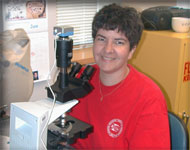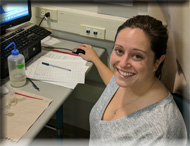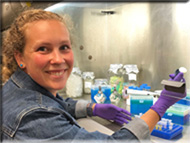Research and Education Assistant III
 Ms. Bridget Holohan
Ms. Bridget Holohan
B.S. Oceanography, University of Michigan; M.S. Oceanography, University of Rhode Island.
I have a wide variety of interests in marine science. I am particularly interested in the ecology of organisms and have worked for several years on the introduction of exotic marine species. I find it very fascinating how an ecosystem responds to the introduction of a new organism. My thesis research focused on the ecology of a burrowing anemone, Ceriantheopsis americanus, in Narragansett Bay.
My experience includes working as a Marine Science Teaching Assistant at the Williams College-Mystic Seaport Maritime Studies Program, Marine Science Instructor at the Wallops Island Marine Science Consortium, Oceanography Instructor at Acadia Institute of Oceanography, and a Research Associate at Williams College-Mystic Seaport Maritime Studies Program.
In addition to research, I am interested in teaching people about marine science. I enjoy interacting in an experiential teaching environment. I feel that “hands-on” learning is a very effective approach to education and therefore, try to employ this method whenever possible. It has been my experience that people gain a greater understanding and retain that understanding better if they are able to actually observe the scientific principles acting in nature.
Current Post Doctoral Researchers
We are currently searching for a postdoctoral researcher to join our laboratory in the spring of 2024. The position focuses on the microbiome of benthic marine invertebrates. A full description of the position and application instructions can be found here: https://jobs.hr.uconn.edu/en-us/job/498013/postdoctoral-research-associate-marine-sciences.
Current Graduate Students & Their Research
 Dr. Kayla Mladinich, Ph.D. Student
Dr. Kayla Mladinich, Ph.D. Student
B.S. Marine Sciences & Biology, University of Tampa, Tampa, FL; M.Sc. Biology, Long Island University-Post, Long Island, NY; Ph.D. Oceanography, University of Connecticut (graduated fall 2023).
I have spent my time in the Ward lab focused on microplastics and their interactions with suspension-feeding invertebrates. My research has taken me out to the field to investigate how microplastics (shape, size, polymer) ingested by oysters relate to those in the surrounding environment on a recreational bed and at various aquaculture sites. In the laboratory, I exposed oysters and mussels to various combinations of microplastics of different shapes, sizes, and polymers to investigate selective suspension-feeding mechanisms and repeated the work with sea grapes and slippersnails to determine an appropriate bioindicator species for microplastics. Results have shown that microplastic concentrations are low across environmental media (sediment, water, biota, marine aggregates) and that the investigated suspension feeders reject larger microplastics (fiber, spheres) at higher proportions than smaller particles. Ingested microplastics can be egested quickly, suggesting it would be difficult to find a representative bioindicator species for microplastics in the surrounding environment as the particles are not retained in the tissues (>20 um). In January, I will be moving to Washington DC to begin working as a Knauss Fellow with NOAA.
 Mr. Tyler Griffin, Ph.D. Student
Mr. Tyler Griffin, Ph.D. Student
B.S. Biology & Mathematics, Linfield College, McMinnville, OR; M.S. (non-thesis) Oceanography, University of Connecticut, Groton, CT.
I am interested in the microbial ecology of invertebrate animals, especially bivalve molluscs and their gut microbiota. Specifically, my PhD research investigates the resident and transient bacterial communities associated with mussel digestive physiology and the responses of those communities to anthropogenic disturbances. My aims include combining laboratory manipulations and field sampling along with classic physiological and modern high-throughput molecular techniques to investigate the symbioses between bivalves and their associated microbiota.
 Ms. Hannah Collins, Ph.D. Student
Ms. Hannah Collins, Ph.D. Student
B.S. Biology, Gettysburg College, Gettysburg, PA; M.Sc. Oceanography, University of Connecticut, CT.
My research interests are focused on the dynamics of the gut microbiome of suspension-feeding bivalves, and how both the host and the associated microbial community interact with environmental contaminants such as microplastics. Specifically, I am interested in investigating how gut microbes are influenced by the prokaryotic community that develops on microplastics, and whether bivalves can be used to co-concentrate microplastics with hydrocarbon-degrading bacteria. I conduct laboratory exposure experiments and feeding assays to investigate how both marine and freshwater bivalves process microplastics, and whether the resident gut microbial community can be manipulated through exposure to specific microbes.

Ms. Danielle Buttermore, M.Sc. Student
B.S. Marine Science, Jacksonville University, Jacksonville, FL.
My research examines the role of photoperiod on the gonadal development of Crassostrea viriginica. Studies of the closely related Crassostrea gigas have illustrated that manipulation of photoperiod and temperature can be used to condition oysters out of season. However, these experiments combined the effects of temperature and photoperiod into one factor. Isolating photoperiod and studying its effects on oyster condition has not been carried out. I also work full time in the Noank bivalve hatchery in Connecticut (Mystic Oyster Co.).
Current Undergraduates Students & Their Research
Check back later to see who will be working in our laboratory in the spring and summer of 2024.
FORMER GRADUATE STUDENTS
Dr. Vena [Haynes] Offen, Biology, Pacific University; M.S. Environmental Science & Engineering, Oregon Health & Science University; Ph.D. Oceanography, University of Connecticut (graduated fall 2019).
Vena studied the impacts of nanoparticles, which are emerging pollutants commonly found in industrial and consumer products, on planktonic and benthic organisms. In particular, she examined how the toxicity of titanium dioxide nanoparticles increased with exposure to natural UV radiation. Her research helped determine the ecotoxicological effects of these manufactured materials under natural environmental conditions. Vena is now a Visiting Assistant Professor at Boston College.
Dr. Melissa Pierce, B.S. Marine Biology, Roger Williams University; Ph.D. Oceanography, University of Connecticut (graduated fall 2016). Melissa examined the microbiome of marine aggregates and shellfish, connecting microbial ecology and public health issues. Specifically, her research focused on the bacterial communities of oysters and mussels, and she examined how capture and ingestion of marine aggregates mediate these communities. She also studied the relationship between the bivalve microbiome and overall health of the organism, including how gut microbiomes may affect the susceptibility and transmission of bivalve diseases. Currently, Melissa is the Technical Program Director at Current Water Innovations, Chicago.
Dr. Maria Rosa, B.S. Biology, The City College, New York; M.S. Oceanography, University of Connecticut; Ph.D. Oceanography, University of Connecticut (graduated fall 2016). Maria’s research focused on particle capture and selection in bivalves. She examined how surface properties (e.g., surface charge, wettability, carbohydrate characteristics) affected these processes using bioassay guided approaches. By using bivalves with different gill morphologies (i.e., gill types), she was able to probe subtle differences between the selection mechanisms of mussels and oysters. Data gathered from this study increased our understanding of how bivalves capture and differentiate food and non-food particles. Maria is an Assistant Professor in the Department of Biology at Connecticut College, New London.
Dr. John Doyle, B.S. Biology, Saint Peter’s College, Jersey City; M.S. Molecular Biology, Montclair State University, Montclair; M.S. Criminalistics, University of New Haven, West Haven; Ph.D. Oceanography, University of Connecticut (graduated spring 2014). John studied the accumulation of nanoparticles in suspension-feeding bivalves, and the potential deleterious effects on immune cells (hemocytes). His results demonstrated that oysters and mussels can ingest titania nanoparticles (anatase, P25, and a nanocomposite) because when immersed in seaswater they form large agglomerates that can be captured by the gill. Following an acute exposure (hours) nanoparticles accumulate in the digestive tract, but are rapidly eliminated in the feces, with little accumulation after 24 hrs post-exposure. Additionally, exposure of oyster hemocytes (in vitro) to bulk or nanoparticulate titania under dark and environmentally-relevant light regimes produce minimal effects on hemocyte viability, phagocytosis, or production of reactive oxygen species. John’s research results provide important information regarding the uptake of titania nanoparticles by bivalves and subsequent effects. John is currently the Education Director of the Gloucester Marine Genomics Institute in MA.
Dr. Dane Frank, B.S. Marine Science with a Biology concentration, Southampton College, LIU; M.S. Oceanography, University of Connecticut; Ph.D. Oceanography, University of Connecticut (graduated winter 2010). Dane examined how several species of bivalves control suspension feeding and respond to changing food quantity and quality. Using particle image velocimetry to visualize and calculate flow fields, he quantified the relationships between feeding, valve gape and pumping rates under laboratory conditions. Among other results, Dane found that both autonomous and physiological regulatory mechanisms of control can be employed by bivalves in species-specific manners. Dane is currently an adjunct faculty member at UConn.
Mr. Dustin Kach, B.S. Coastal Studies, University of Connecticut; M.S. Oceanography, University of Connecticut (graduate spring 2009). Dustin’s research focused on trophic interactions between suspension feeders and aggregated material. He demonstrated that aggregates serve as a means by which bivalves and other suspension feeders can uptake very small particles such as pico- and nanoplankton; particles that they would not be able to efficiently capture if freely suspended. Dustin is a Project Manager and Field Scientist at Ocean Surveys, Inc. (Old Saybrook).
Dr. Maille Lyons, B.S. Biology,University of Massachusetts, Dartmouth; M.A. Biology, University of California, Los Angeles; Ph.D. Oceanography, University of Connecticut (graduated summer 2008). Maille’s work focused on the ecological role of marine aggregates as a link between pathogens (e.g., Vibrio spp., Perkinsus marinus, QPX) and benthic, suspension-feeding bivalves (e.g., oysters, clams). Among other findings, her work demonstrated that aggregates could serve as a reservoir for the clam pathogen, Quahog Parasite X (a protozoan), and might provide an ecological link between the parasite and its host. Maille was also employed as a post-doctroal researcher in my laboratory (see below), and is now a Patent Examiner at the US Patent and Trademark Office where she reviews patents for the biotechnology sector.
Dr. Binglin Li, B.S. Xiamen University, Fujian Province, China; M.S. Oceanography, University of Connecticut (graduated summer 2006). Binglin’s research demonstrated that transparent exopolymer particles (TEP), which are abundant in the marine environment and can form from dissolved organic precursors, enhance the formation of marine aggregates. Using methods developed by Heinonen and McKee (see below), Binglin collected TEP from mussels and tunicates and demonstrated that these compounds do enhance particle aggregation. His laboratory results suggest that suspension feeders play a role in aggregation processes in coastal waters, and provide new information concerning populations of suspension-feeders and benthic-pelagic coupling.
Ms. Kari Heinonen, B.S. Biology, Eastern Connecticut State University; M.S. Oceanography, University of Connecticut (graduated summer 2004). Kari’s research complemented and extended the results obtained by Mike McKee (see below) and focused on the release of transparent exopolymer particles (TEP) by benthic suspension feeders. Her results demonstrated that a number of benthic suspension feeders, including scallops, slipper snails, mussels and tunicates significantly contribute to the TEP pool.
Mr. Michael McKee, B.A. Zoology and Anthropology, Miami University; M.S. Oceanography, University of Connecticut (graduated spring 2001). Mike’s research examined the release of TEP by the oyster, Crassostrea virginica, blue mussel, Mytilus edulis, and several species of soft corals. His results demonstrated that oysters release significant quantities of TEP into the environment. Mike is now a Manager of Clinical Systems at eClinical Solutions.
Dr. Lisa Milke, B.S. Biology, Salisbury State University; B.S. Environmental Marine Science, University of Maryland Eastern Shore; M.S. Oceanography, University of Connecticut (graduated spring 2001). Lisa’s research focused on the transport and handling of particles within the pallial cavity of two species of bivalves: Mytilus edulis, and Crassostrea virginica. Her work examined how particle handling in the pallial cavity changed when the bivalves were exposed to particulate diets of different quality and concentration. Lisa finished a PhD at Dalhousie University (Canada) with Dr. Monica Bricelj. She is now Chief of the Ecosystems and Aquaculture Division, NOAA Fisheries, US Department of Commerce.
FORMER POST-DOCTORAL FELLOWS
Dr. Martina Cappriota, Ph.D. B.S. Marine Environmnetal Biology, University of Camerino, Italy; M.S. Marine Biology, Polytechnic University of Marche, Italy; Ph.D. Life and Health Sciences, International School of Advanced Studies, Camerino University, Italy.
Martina is interested in the biology and toxicology of marine vertebrates and invertebrates. Her work has focused on the molecular effects of chemical contaminants on endocrine, metabolic, and toxicity pathways using selected biomarkers. More recently she has become interested in the impacts of microplastics and adsorbed chemicals on marine organisms. In my laboratory, Martina studies how intrinsic and extrinsic factors affected the feeding physiology of suspension feeders.
Dr. Lisa Nigro, Ph.D. B.S. Rutgers University, New Brunswick, NJ; M.S. University of Maine, Orono, ME; Ph.D. University of North Carolina, Chapel Hill, NC.
Lisa’s research interests focused on microbial community structure and evolution, from large scale community studies that explore how microbes interact with each other and their environment to the genetic makeup of an individual organism that allows it to survive and persist in its environment. In order to explore these research questions, she utilized next generation Illumina 16S rRNA gene amplicon sequencing. Lisa is now an Assistant Professor in the Biology Department at Central Connecticut State University.
Dr. Maille Lyons, B.S. Biology, University of Massachusetts, Dartmouth; M.A. Biology, University of California, Los Angeles; Ph.D. Oceanography, University of Connecticut. Maille’s research focused on the ecological role of marine aggregates as a link between water-borne pathogens (e.g., Vibrio spp., Listeria spp., Perkinsus marinus, MSX, QPX) and benthic, suspension-feeding bivalves (e.g., oysters, clams, mussels and scallops). Her research demonstrated that marine aggregates can serve as reservoirs by concentrating marine pathogens within their matrix. Maille is currently a Patent Examiner at the US Patent and Trademark Office where she reviews patents for the biotechnology sector.
Dr. Kevin Strychar, B.S. Marine Biology, University of New Brunswick; M.S. Marine Biology/Microbiology, University of New Brunswick; Ph.D. Marine Molecular Biology/Biochemistry, Central Queensland University. Kevin’s research focused on nutrient dynamics and phytoplankton assemblages in Long Island Sound. This research was carried out in collaboration with Dr. Gary Wikfors (Milford NMFS), and funded by a grant from the Environmental Protection Agency (EPA – USA). Kevin is currently an Associate Professor at the Annis Water Resources Institute – Grand Valley State University.
FORMER UNDERGRADUATE STUDENTS
Ms. Mya Darsan, Biology, University at Albany (graduated). Mya was an NSF-REU intern in our laboratory in the summer of 2022. Her research project investigated the nutritional physiology of blue and ribbed mussels in Long Island Sound with a reciprocal transplant.
Ms. Marissa Scott, Biology, Saint Michael’s College (graduated). Marissa was an NSF-REU intern in our laboratory in the summer of 2021. Her research project experimentally examined the role of gut microbiota in the digestive function of blue mussels.
Ms. Larissa Tabb, Marine Sciences, University of Connecticut (graduated). Larissa was an undergraduate intern in our laboratory in the summers of 2020 & 2021. She has helped with a variety of projects and focused on examining the capture efficiency of picoplankton by marine suspension feeders. Her work was funded through the NSF, IOS program.
Ms. Julia Baer, Biology, Mount Saint Mary’s University (graduated).
Julia was an NSF-REU intern in our laboratory in the summmer of 2019. Her research focused on the microbiome of the blue mussel (Mytilus edulis), specifically examing if the microbial communities of feces are a good proxy for those in the stomach. Her work was funded through the NSF, Mystic Aquarium-UConn REU site program.
Ms. Yoselyn Flores, Biology, University of Illinois (graduated).
Yoselyn was an NSF-REU intern in our laboratory in the summmer of 2017. Her research focused on the effects of microplastics and associated surfactants on the feeding rates of blue mussels (Mytilus edulis). Her work was funded through the NSF, Mystic Aquarium-UConn REU site program.
Ms. Abby Plungis, B.S. Student, Biology, University of Connecticut (graduated).
Abby worked in our laboratory on a project funded by the USDA. She was involved in research that examines the uptake and elimination of engineered nanoparticles by commercially important bivalves, and the incorporation of microplastics into marine aggregates.
Ms. Elizabeth Eudy, Biology, University of Connecticut (graduated).
Liz worked in our laboratory as a research intern on a project funded by CT Sea Grant that examined: 1) the distribution of Vibrio parahaemolyticus in Long Island Sound, and 2) uptake of Vp by oysters.
Ms. Ashley Frink, Marine Sciences, University of Connecticut (graduated).
Ashley worked in our laboratory as a research intern on a grants funded by the National Science Foundation (IOS). The work addressed the mechanisms of particle selection in bivalves.
Ms. Meghan Danley, Marine Biology, University of New England (graduated).
Meg worked in our laboratory in the summers of 2013 and 2014, completing an independent study and working on a project funded by the CT Sea Grant and the National Science Foundation (Envrionmental Nanotechnology).
Ms. Maggie Heraty, Environmental Studies (minor: Geology), Oberlin College (graduated). Maggie worked in our laboratory as an Oceans and Human Health summer intern (supported by I-RICH; summer 2013). She assisted with several projects including the uptake of nanoparticles by bivalve molluscs, and changes in the bacterial communities of the oyster, Crassostrea virginica.
Ms. Anusha Perumalla, Biology, University of Connecticut (graduated). Anusha worked in our laboratory as a summer research intern on a grant funded by the National Science Foundation (EEID). Her work focused on changes in the bacterial communities of the oyster, Crassostrea virginica.
Ms. Caitlin Miller, Molecular and Cell Biology, University of Connecticut (graduated). Caitlin worked in our laboratory as a summer research intern on a grant funded by the National Science Foundation (EEID, summer 2011). Her work focused on changes in the bacterial communities of the oyster, Crassostrea virginica.
Ms. Kate Morozova, Ecology and Evolutionary Biology, University of Connecticut, (graduated). Kate worked in our laboratory as a summer research intern on a grant funded by CT Sea Grant and NOAA’s Oceans and Human Health Initiative (I-RICH, summer 2011). She helped with studies examining the uptake of nanoparticles by bivalve molluscs.
Ms. Christine Depierro, MPH, Southern Connecticut State University (graduated). Christine worked in our laboratory as an Oceans and Human Health summer intern (supported by I-RICH; summer 2010). She worked on two projects: the uptake of nanoparticles by bivalve molluscs, and the impacts of grazing by microzooplankton on blooms of toxic dinoflagellates
Mr. Eric Heupel, Coastal Studies, University of Connecticut (graduated). Eric worked with us as a summer research intern, funded by a grant from the National Science Foundation (summers 2008, 2009). He developed age-appropriate educational packets that demonstrate fundamental biological principles of bivalves molluscs.
Ms. Gina Ralph, Coastal Studies, University of Connecticut (graduated). Gina worked in my laboratory as a summer research intern, funded by a grant from the National Science Foundation (summers 2006, 2007). She not only helped with laboratory research involving the ecology of bivalve diseases, but also completed an honors research project on the oyster disease Dermo.
Ms. Meaghan Cosker, Biological Sciences, University of Connecticut (graduated). Meaghan worked with us as a summer research intern, funded by a grant from the National Science Foundation, Integrative Biology Program (summer 2006). She assisted with laboratory research on the physiology of bivalve feeding.
Ms. Katie Levasseur, Ecology and Evolutionary Biology, University of Connecticut (graduated). Katie worked in my laboratory as a summer research intern, funded by the National Science Foundation (summer 2005). Katie worked with us on the ecology of two diseases of bivalves, QPX and Dermo.
Ms. Cheryl Danis, Non-matriculated, University of Connecticut. Cheryl worked in my laboratory as a summer research intern, funded by the National Science Foundation (summer 2005). She assisted us with laboratory research on the physiology of bivalve feeding.
Mr. Dustin Kach, Coastal Studies, University of Connecticut (graduated). Dustin worked in my laboratory as a summer research intern, funded by the Environmental Protection Agency (summer 2002, 2003, 2004). Dustin also completed an independent research project with me in the fall of 2003. His research focused on differences in phytoplankton assemblages in the eastern, central, and western Long Island Sound. Dustin began graduate studies in my lab in January 2005.
Ms. Kristen Barrett, Coastal Studies, University of Connecticut (graduated). Kristen worked in my laboratory as a summer research intern, funded by the National Science Foundation (summer 2004). For her research she examined the uptake of phytoplankton by the slipper snail, Crepidula fornicata.
Ms. Lisa (Le) Ewert, Southampton College, LIU (graduated). Le worked in my laboratory as a summer Research Experience for Undergraduates fellow, funded by the National Science Foundation (NSF-REU), Division of Ocean Sciences (summer, 2000). Her research project focused on the effects of “China” clay and silt on the feeding behavior and physiology of benthic suspension feeders.
Ms. Kristen Murphy, The College of William & Mary (graduated). Kristen worked in my laboratory as an NSF-REU, CAREER/Ocean Sciences (summer, 2000). Her research project focused on: 1. predator-prey Interactions between juvenile fishes and nudibranchs, and 2. the influence of suspended food quality and quantity on the feeding responses of the eastern oyster, Crassostrea virginica.
Ms. Nicholanna (Nicky) Halladay, Salisbury State University (graduated). Nicky worked in my laboratory as an NSF-REU, CAREER/Ocean Sciences (summer, 1999). Her research project focused on the influence of suspended food quality and quantity on the feeding and digestive responses of the eastern oyster, Crassostrea virginica.
Ms. Kerri Bentkowski, Salisbury State University (graduated). Kerri worked in my laboratory as an NSF-REU, Division of Ocean Sciences. Her research focused on the effects of water viscosity on particle capture in marine mussels (Mytilus edulis).
Ms. Heather Small, Salisbury State University (graduated). Heather completed an honors research project in my laboratory (1996-1997). Her research examined the symbiotic relationship between the polychaete worm, Polydora websteri, and the oyster, Crassostrea virginica.

“Babs”, Undeclared, Babs was traded from the Chicago Bulls to the University of Connecticut to play on the women’s basketball team. She is interested in marine biology and makes occasional appearances in my laboratory. Someday, Babs hopes to back-pack through Europe (with a very small back-pack).
Note: Research material is based upon work supported by the National Science Foundation, National Institutes of Health, and National Oceanographic and Atmospheric Association. Any opinions, findings and conclusions, or recommendations expressed in this material are those of the author and do not necessarily reflect the views of these agencies